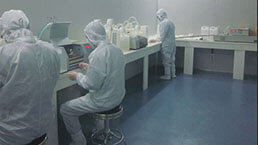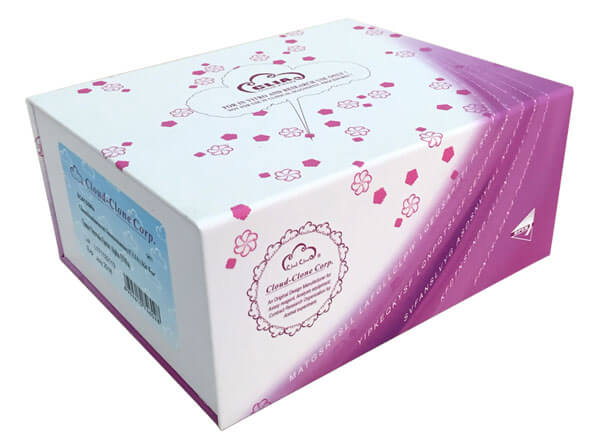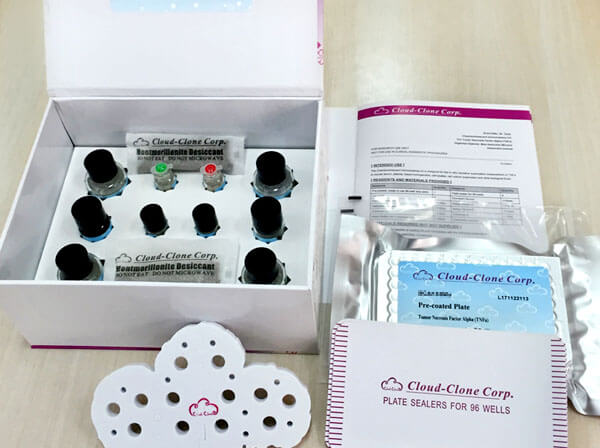CLIA Kit for Chemokine (C-X-C motif) ligand 7 ( CXCL7) 

CXCL7; PPBP; PBP; B-TG1; CTAP-III; CTAP3; CTAPIII; LA-PF4; LDGF; MDGF; NAP2; SCYB7; TC1; TC2; TGB1; THBGB1; Pro-Platelet Basic Protein; Beta-Thromboglobulin
- UOM
- FOB US$ 638.00 US$ 912.00 US$ 4,104.00 US$ 7,752.00 US$ 63,840.00
- Quantity
Overview
Properties
- Product No.SCA370Ra
- Organism SpeciesRattus norvegicus (Rat) Same name, Different species.
- ApplicationsChemiluminescent immunoassay for Antigen Detection.
Research use only - DownloadInstruction Manual
- CategoryCytokineHematology
Sign into your account
Share a new citation as an author
Upload your experimental result
Review

Contact us
Please fill in the blank.
Recovery
Matrices listed below were spiked with certain level of recombinant Chemokine (C-X-C motif) ligand 7 ( CXCL7) and the recovery rates were calculated by comparing the measured value to the expected amount of Chemokine (C-X-C motif) ligand 7 ( CXCL7) in samples.
| Matrix | Recovery range (%) | Average(%) |
| sodium citrate plasma(n=5) | 86-96 | 92 |
Precision
Intra-assay Precision (Precision within an assay): 3 samples with low, middle and high level Chemokine (C-X-C motif) ligand 7 ( CXCL7) were tested 20 times on one plate, respectively.
Inter-assay Precision (Precision between assays): 3 samples with low, middle and high level Chemokine (C-X-C motif) ligand 7 ( CXCL7) were tested on 3 different plates, 8 replicates in each plate.
CV(%) = SD/meanX100
Intra-Assay: CV<10%
Inter-Assay: CV<12%
Linearity
The linearity of the kit was assayed by testing samples spiked with appropriate concentration of Chemokine (C-X-C motif) ligand 7 ( CXCL7) and their serial dilutions. The results were demonstrated by the percentage of calculated concentration to the expected.
| Sample | 1:2 | 1:4 | 1:8 | 1:16 |
| sodium citrate plasma(n=5) | 84-104% | 90-102% | 82-93% | 95-103% |
Stability
The stability of kit is determined by the loss rate of activity. The loss rate of this kit is less than 5% within the expiration date under appropriate storage condition.
To minimize extra influence on the performance, operation procedures and lab conditions, especially room temperature, air humidity, incubator temperature should be strictly controlled. It is also strongly suggested that the whole assay is performed by the same operator from the beginning to the end.
Reagents and materials provided
| Reagents | Quantity | Reagents | Quantity |
| Pre-coated, ready to use 96-well strip plate | 1 | Plate sealer for 96 wells | 4 |
| Standard | 2 | Standard Diluent | 1×20mL |
| Detection Reagent A | 1×120µL | Assay Diluent A | 1×12mL |
| Detection Reagent B | 1×120µL | Assay Diluent B | 1×12mL |
| Substrate A | 1×10mL | Substrate B | 1×2mL |
| Wash Buffer (30 × concentrate) | 1×20mL | Instruction manual | 1 |
Assay procedure summary
1. Prepare all reagents, samples and standards;
2. Add 100µL standard or sample to each well. Incubate 1 hours at 37°C;
3. Aspirate and add 100µL prepared Detection Reagent A. Incubate 1 hour at 37°C;
4. Aspirate and wash 3 times;
5. Add 100µL prepared Detection Reagent B. Incubate 30 minutes at 37°C;
6. Aspirate and wash 5 times;
7. Add 100µL Substrate Solution. Incubate 10 minutes at 37°C;
8. Read RLU value immediately.

Test principle
The microplate provided in this kit has been pre-coated with an antibody specific to Chemokine (C-X-C motif) ligand 7 ( CXCL7). Standards or samples are then added to the appropriate microplate wells with a biotin-conjugated antibody specific to Chemokine (C-X-C motif) ligand 7 ( CXCL7). Next, Avidin conjugated to Horseradish Peroxidase (HRP) is added to each microplate well and incubated. Then the mixture of substrate A and B is added to generate glow light emission kinetics. Upon plate development, the intensity of the emitted light is proportional to the Chemokine (C-X-C motif) ligand 7 ( CXCL7) level in the sample or standard.;
Giveaways
Increment services
-
 Single-component Reagents of Assay Kit
Single-component Reagents of Assay Kit
-
 Lysis Buffer Specific for ELISA / CLIA
Lysis Buffer Specific for ELISA / CLIA
-
 Quality Control of Kit
Quality Control of Kit
-
 CLIA Kit Customized Service
CLIA Kit Customized Service
-
 Disease Model Customized Service
Disease Model Customized Service
-
 Serums Customized Service
Serums Customized Service
-
 TGFB1 Activation Reagent
TGFB1 Activation Reagent
-
 Real Time PCR Experimental Service
Real Time PCR Experimental Service
-
 Streptavidin
Streptavidin
-
 Fast blue Protein Stain solution
Fast blue Protein Stain solution
-
 Single-component Reagents of FLIA Kit
Single-component Reagents of FLIA Kit
-
 Streptavidin-Agarose Beads
Streptavidin-Agarose Beads
Citations
- Strict heart rate control attenuates prothrombotic state and platelet activity in patients with non-valvular permanent atrial fibrillation.Pubmed: 2347822
- STUDIES ON THE STORAGE OF POOLED PLATELETS IN NON DOP PVC CONTAINERSEbscohost: Source
- Bioprofiling of platelets in medicated patients with depression.Pubmed:25451399
- Ex vivo simulation of cardiopulmonary bypass with human blood for hemocompatibility testingPubMed: 26243277
- Differential changes in platelet reactivity induced by acute physical compared to persistent mental stressPubMed: 26192713
- Bioprofiling of platelets in medicated patients with depressionPubMed: 25451399
- Markers of coagulation and fibrinolysis do not detect or predict the presence of left atrial appendage thrombus in patients with atrial fibrillationPubmed: 32147650
- A novel di‐peptide Met‐Glu from collagen hydrolysates inhibits platelet aggregation and thrombus formation via regulation of Gq‐mediated signalingPubmed: 32662128
- Endogenous Nitric Oxide-Releasing Microgel Coating Prevents Clot Formation on Oxygenator Fibers Exposed to In Vitro Blood FlowPubmed:35054599
- The effect of ChAdOx1 nCov-19 vaccine on arterial thrombosis development and platelet aggregation in female ratsPubmed:35183388







